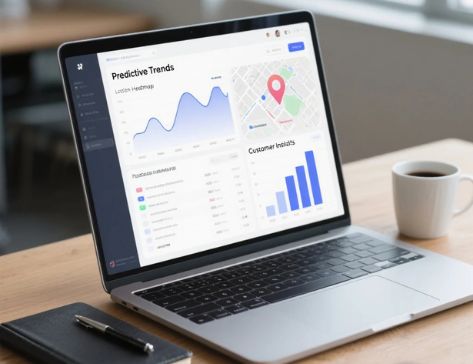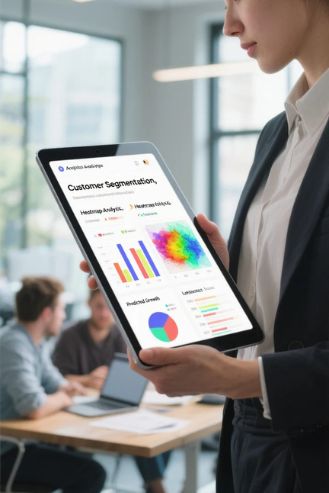
Predictive Analytics for Local Marketing: Complete Guide to Data-Driven Success
Predictive analytics for local marketing has revolutionized how businesses connect with their community-based customers, enabling unprecedented precision in targeting and campaign optimization. This comprehensive guide will walk you through everything you need to know about implementing predictive analytics strategies that drive real results for local businesses.
Local businesses today face intense competition and changing consumer behaviors. Traditional marketing approaches often fall short in delivering the personalized experiences customers expect. By leveraging predictive analytics in retail and local marketing, businesses can anticipate customer needs, optimize resource allocation, and significantly improve their return on investment.

Understanding Predictive Analytics in Local Marketing Context
Predictive analytics involves using historical data, statistical algorithms, and machine learning techniques to identify patterns and predict future outcomes. In local marketing, this translates to understanding customer behavior patterns, seasonal trends, and market dynamics specific to your geographic area.
Key Components of Local Marketing Analytics
- Customer Demographics Analysis: Understanding age groups, income levels, and lifestyle preferences in your local market
- Geographic Data Integration: Mapping customer locations, traffic patterns, and competitor presence
- Seasonal Trend Identification: Recognizing local events, weather patterns, and seasonal buying behaviors
- Competitive Intelligence: Monitoring local competitor activities and market positioning
Essential Steps to Implement Predictive Analytics for Local Marketing
Step 1: Data Collection and Integration
Begin by gathering data from multiple sources including point-of-sale systems, customer relationship management platforms, social media interactions, and website analytics. Local businesses should also incorporate external data sources such as local economic indicators, weather patterns, and community event calendars.
Pro Tip: Start with the data you already have. Most local businesses possess valuable customer information that can be analyzed immediately without additional investment in new systems.
Step 2: Customer Segmentation and Profiling
Use predictive models to segment your local customer base into distinct groups based on purchasing behavior, frequency of visits, and lifetime value. This segmentation enables targeted marketing campaigns that resonate with specific customer groups.
- Analyze purchase history and frequency patterns
- Identify high-value customer characteristics
- Create behavioral profiles for different segments
- Develop personalized messaging strategies for each segment
Step 3: Predictive Model Development
Develop models that can forecast customer behavior, optimal pricing strategies, and campaign performance. Focus on models that address specific local marketing challenges such as foot traffic prediction, seasonal demand forecasting, and customer churn prevention.
Advanced Strategies for Local Marketing Success
Location-Based Predictive Modeling
Leverage geographic information systems (GIS) data to predict customer movement patterns and optimize store locations, delivery routes, and targeted advertising zones. This approach helps local businesses understand how physical location impacts customer behavior and purchasing decisions.
Building comprehensive marketing intelligence systems requires integrating multiple data sources and analytical tools. Local businesses can benefit from understanding customer journey mapping, conversion funnel optimization, and multi-channel attribution modeling.
Real-Time Campaign Optimization
Implement systems that can adjust marketing campaigns in real-time based on predictive insights. This includes dynamic pricing strategies, personalized offer timing, and automated customer re-engagement campaigns.
Tools and Technologies for Local Marketing Analytics
Essential Analytics Platforms
- Google Analytics 4: Advanced attribution modeling and predictive metrics
- Facebook Analytics: Local audience insights and behavior prediction
- Customer Data Platforms: Unified customer view and predictive scoring
- Point-of-Sale Analytics: Transaction pattern analysis and forecasting
Machine Learning Applications
Implement machine learning algorithms for customer lifetime value prediction, churn analysis, and recommendation engines. These technologies can automatically identify patterns that human analysts might miss and continuously improve prediction accuracy.
Measuring Success and ROI
Key Performance Indicators
Track specific metrics that demonstrate the impact of predictive analytics on your local marketing efforts:
- Customer acquisition cost reduction
- Increased customer lifetime value
- Improved campaign conversion rates
- Enhanced customer retention rates
- Optimized marketing spend allocation
Continuous Improvement Process
Establish regular review cycles to assess model performance, update data sources, and refine predictive algorithms. Local market conditions change frequently, requiring adaptive analytics approaches that can evolve with your business environment.
Common Challenges and Solutions
Data Quality and Integration Issues
Many local businesses struggle with inconsistent data formats and incomplete customer information. Address these challenges by implementing data governance policies, investing in data cleaning tools, and establishing standardized data collection procedures.
Resource Constraints
Small and medium-sized local businesses often lack dedicated analytics teams. Consider partnering with analytics service providers, using automated analytics platforms, or investing in staff training to build internal capabilities.
Future Trends in Local Marketing Analytics
Artificial Intelligence Integration
AI-powered analytics tools are becoming more accessible to local businesses, offering sophisticated predictive capabilities without requiring extensive technical expertise. These tools can automate complex analysis tasks and provide actionable insights in real-time.
Privacy-First Analytics
With increasing privacy regulations, local businesses must adopt analytics approaches that respect customer privacy while still delivering valuable insights. Focus on first-party data collection and transparent data usage policies.
Conclusion
Predictive analytics for local marketing represents a powerful opportunity for businesses to gain competitive advantages in their communities. By following the strategies and steps outlined in this guide, local businesses can harness the power of data to make informed decisions, optimize marketing investments, and build stronger customer relationships.
Success with predictive analytics requires commitment to data quality, continuous learning, and adaptive strategies that evolve with changing market conditions. Start with simple implementations and gradually build more sophisticated analytical capabilities as your business grows and your data maturity increases.
Remember that effective local marketing analytics is not just about the technology—it’s about understanding your customers, your community, and your unique market position. Use advanced advertising intelligence tools to stay ahead of competitors and continuously refine your predictive marketing strategies for sustained local business success.


